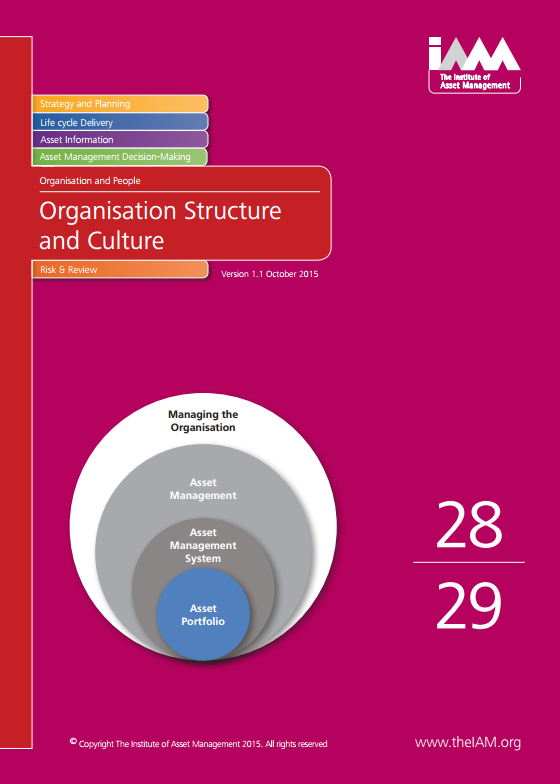Subjects 28 & 29: Organisation Structure and Culture
Version 1.1 October 2015
The structure and culture of an organisation have a profound effect on how people perceive asset management. This includes what is perceived as good practice, how much change is believed possible, how people behave and how committed they feel to goals and objectives.
Organisational structure refers to the way in which people within an organisation are organised and the groupings within which they have to work. Culture is a social construct that refers shared meaning of work, values, attitudes or beliefs thought to affect long-term behaviour and performance.
The structure of an organisation can have a major influence on the culture of an organisation, and vice versa.
Each organisation should decide what type of structure and culture best suits its needs.
With thanks to our sponsors of this publication.
| CONTENTS | |
|---|---|
| Acknowledgements | 2 |
| 1 INTRODUCTION TO SUBJECT SPECIFIC GUIDELINES 1.1 Purpose of the SSGs 1.2 The SSGs In Context 1.3 SSGs And The Issue Of Complexity Versus Maturity 1.4 Further reading 1.5 Scope of this SSG 1.6 How to use this SSG |
4 |
| 2. WHAT IS ORGANISATIONAL STRUCTURE AND CULTURE? 2.1 The Importance of Structure and Culture 2.2 Difference between Structure and Culture 2.3 Organisational Structure 2.3.1 What is it? 2.3.2 Why is it important? 2.3.3 Benefits of correctly aligned organisational structure 2.3.4 Key guidance on organisational structure 2.4 Organisational Culture 2.4.1 What is Culture? 2.4.2 Why is organisational culture important? 2.4.3 Benefits of correctly aligned organisational culture 2.4.4 Key guidance on organisational culture |
6 |
| 3. KEY PRINCIPLES 3.1 Key Factors 3.1.1 Culture 3.1.2 Climate 3.1.3 Relationship between culture & climate 3.1.4 Where does culture come from? 3.1.5 Dimensions of Culture 3.1.6 Structure 3.1.7 Examples of organisational structure 3.1.8 Line of Sight 3.1.9 Leadership Commitment 3.1.10 Structural and cultural change 3.1.11 Consistency of Application 3.1.12 Viability 3.2 Questions to address when considering how well the structure and culture of your organisation supports its asset management objectives |
8 |
| 4. GUIDANCE FOR ORGANISATION, STRUCTURE AND CULTURE 4.1 Understanding the purpose of the organisation 4.2 Understanding the need for change 4.2.1 Triggers for change 4.3 Identifying necessary Structural and Cultural changes 4.4 Managing Structural and Cultural Change 4.5 Sustaining benefits of change |
12 12 12 12 14 14 16 |
| 5. REFERENCES AND FURTHER READING 5.1 References 5.2 Further Reading |
18 18 18 |

















